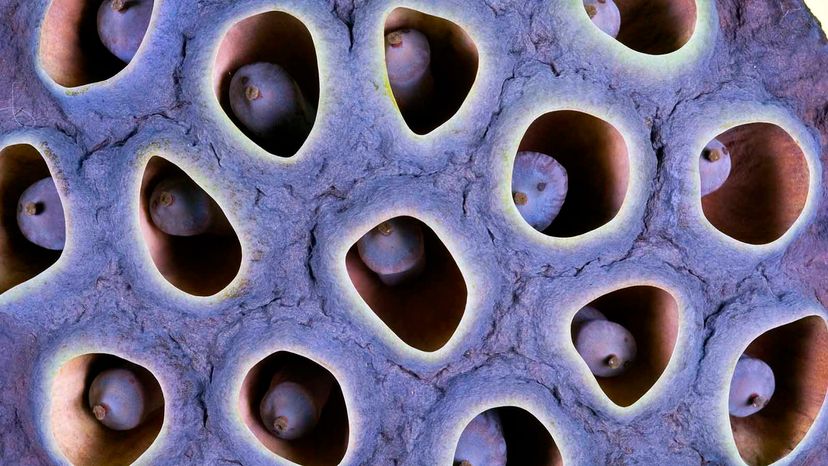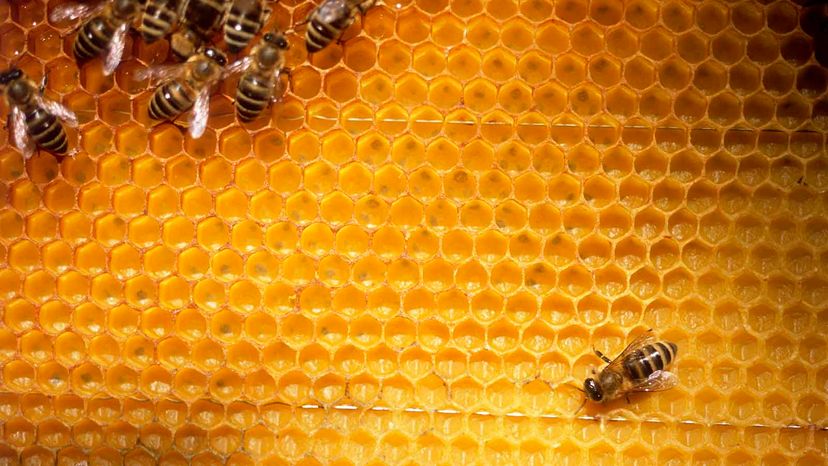 “The seed pod of the lotus flower is one common visual that can trigger thoughts of disgust from someone who has trypophobia. Gail Shumway/Getty Images
“The seed pod of the lotus flower is one common visual that can trigger thoughts of disgust from someone who has trypophobia. Gail Shumway/Getty Images
Close your eyes and picture images of strawberries, honeycombs and bubbly pancake batter. Do thoughts of yummy food from a late summer day come to mine or do you have visions of a horror movie flashing in your head? If you’re one of the thousands of people afflicted with trypophobia that trio of images may have just sent you spiraling.
Trypophobia, in short, is a fear or disgust of closely-packed holes. Those who deal with the issue might experience nausea looking at something like the densely-dotted head of a lotus seed pod or feel sick, sweaty or panicked at the sight of a bubble-filled bathtub. While the name suggests this aversion to holes is some sort of deep-seated, psychologically-based fear, there’s been some debate about whether it qualifies as an actual "phobia" since it’s not officially recognized by the Diagnostic and Statistical Manual of Mental Disorders (DSM).
What Is Trypophobia?
"Trypophobia is not like other phobias," Arnold Wilkins, professor emeritus in the department of psychology at the University of Essex, writes via email. He is one of the world’s leading researchers on a topic known as visual stress. "There is not any one thing that people are affected by and there is no obvious explanation as to why. It’s more of a disgust reaction than a phobia as such."
While phobias are typically characterized by the hallmark symptom of fear, trypophobia seems to mostly revolve around the signature symptom of disgust. And what these people seem to be disgusted by is seeing things like coral, lotus seed pods or even bubbles in their coffee. Basically anything that could have a cluster of holes.
According to a 2018 review, women appear more likely to develop trypophobia, and its most common comorbid diagnoses are major depressive disorder and generalized anxiety disorder. Other symptoms could include:
- Helplessness, disgust or fear
- Goosebumps, itchy skin or feeling your skin crawl
- Dizziness, trembling, shortness of breath
- Sweating, body shakes, racing heartbeat
- Headaches
- Nausea or vomiting
The topic of trypophobia came into Wilkins’s life in an unexpected way: His colleague, Dr. Geoff Cole, brought it to his attention by describing the trypophobic experiences he’d been having since age 13 (starting with a nausea-inducing metal shop project that involved drilling tiny holes into a coin).
"I had been exploring visual discomfort from images and had discovered that the discomfort could be predicted by mathematical measures of how unlike scenes from nature the images were," Wilkins says. "I was then visited by Dr. Geoff Cole who told me about trypophobia and professed to being trypophobic himself. I thought the trypophobic images might have statistics in common with other uncomfortable and unnatural images — and so it proved."
In 2013, Wilkins and Cole published a paper suggesting that trypophobia may be the result of a specific visual feature found among poisonous animals that triggers some evolutionary part of the brain to freak out. They found that about 16 percent of their participants reported trypophobic reactions.
"My interest in trypophobia started with reading Cole and Wilkins’ paper in 2013, ‘The Fear of Holes,’" R. Nathan Pipitone, Ph.D., assistant professor in the department of psychology at Florida Gulf Coast University, writes via email. "The topic connects with my interest in stimuli that invoke evolutionarily relevant responses in humans. After mentioning it to a student who was interested in conducting research with me, we decided to pursue a research project together in 2015."
In 2017, Pipitone published the paper "Physiological responses to trypophobic images and further scale validity of the trypophobia questionnaire," which supported interpretations by Wilkins and Cole, including that "in general, negative reactions are seen among participants that view trypophobic imagery. As Cole and Wilkins (2013) show, these images share similar spatial frequency profiles with dangerous animals."
"The most surprising finding to me is the wide range of responses people have to trypophobic stimuli," Pipitone says. "Our visual perception modalities are highly conserved and there’s usually a lot of agreement in what we all find uncomfortable or pleasing to view. People that suffer from full-blown trypophobia have extreme discomfort when viewing these images (I’ve met several of them), yet for non-trypophobes, they can be almost pleasant to look at."
 “Trypophobia is no joke. Researchers think it could be an evolutionary response to avoiding infectious diseases.Micha Pawlitzki/Getty Images
“Trypophobia is no joke. Researchers think it could be an evolutionary response to avoiding infectious diseases.Micha Pawlitzki/Getty Images
But Why Patterns of Holes?
In 2017, researchers at the University of Kent came up with another theory to explain the unpleasant feelings some people experience when observing patterns of holes. The authors proposed that "aversion to clusters is an evolutionarily prepared response toward a class of stimuli that resemble cues to the presence of parasites and infectious disease." In other words, trypophobics loath parasites and diseases that cause clusters of round shapes, such as measles, rubella, scarlet fever, smallpox, ticks and scabies.
While the researchers state that this response is a normally adaptive response, people with trypophobia experience an "exaggerated and overgeneralised version" of the natural inclination.
Whatever it may be that actually causes a person’s trypophobia, Pipitone says he believes that the variety in trypophobic responses are concrete examples of human individuality and even the need for more empathy and sensitivity to the perceptions of others.
"Just because you don’t have an adverse reaction to the images doesn’t mean others will have the same response," he says. "Since the majority of people do not have trypophobia, they might feel that the response seen in some isn’t justified. In today’s world, we need to focus more on how other people’s subjective reality might be different from our own. This would help us in a lot of ways."
Treating Trypophobia
There is no treatment specific to trypophobia, though there are ways to help those with phobias that may be helpful to reduce the symptoms of trypophobia.
- Exposure therapy "exposes" the person to the what they’re most afraid of in hopes that over time, the fear will decrease.
- Cognitive behavioral therapy involves patients working with a therapist to "change" their thoughts and behaviors that could be causing the trypophobia.
- Relaxation techniques, like deep breathing, may also be help reduce the disgust, fear or anxiety caused by trypophobia.
- Medications for treating depression or anxiety could also lessen the symptoms.
Now That’s Interesting
A few more common triggers of trypophobia include: Bubble Wrap, insect eyes, pomegranates and sea sponges.
Originally Published: Jul 30, 2020
Trypophobia FAQ
Is trypophobia real?
Trypophobia isn’t officially recognized by the Diagnostic and Statistical Manual of Mental Disorders (DSM), however it is a real fear and disgust of closely-packed holes.
What do you call a person who has trypophobia?
People who experience trypophobia may be called trypophobic, a trypophobe, or trypophobics.
What are symptoms of trypophobia?
Trypophobia symptoms include feelings of helplessness, disgust or fear; goosebumps, itchy skin or feeling your skin crawl; dizziness, trembling, or shortness of breath; sweating, body shakes, and a racing heartbeat; headaches; and nausea or vomiting.
What is the origin of the word trypophobia?
The word is believed to be from the Greek words trŷpa, meaning hole, and phóbos, meaning fear.
Can trypophobia be cured?
There is no cure or treatment specific to trypophobia, but techniques that work for some include exposure therapy, cognitive behavioral therapy, relaxation techniques, and in extreme cases anxiety medications.


